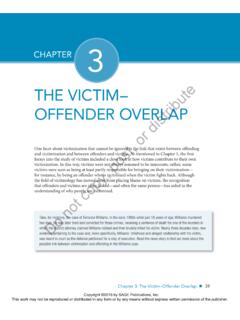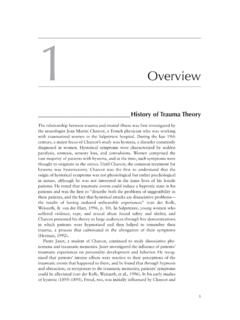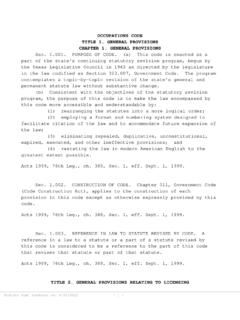Transcription of INTRODUCTION TO CHAPTER 1 CRIMINOLOGY
1 CHAPTER 1 INTRODUCTION TO CRIMINOLOGYO ften, crimes such as the mass shooting in Las Vegas, Nevada, in 2017, lead people to ask, Why do they do it? Copyright 2021 by SAGE Publications, Inc. This work may not be reproduced or distributed in any form or by any means without express written permission of the not copy, post, or distributeChapter 1 INTRODUCTION to CRIMINOLOGY 1 LEARNING OBJECTIVESA fter reading this CHAPTER , you will be able Identify key concepts in understanding Summarize the general structure and organization of the criminal justice Identify and characterize a good theory. Identify key concepts and issues associated with victimology. SapienzaCase StudyThe Confidence Man On July 8, 1849, The New York Herald, in its Police Intelligence section, reported the arrest of William Thompson. The Herald wrote that Thompson had been scamming men he met on the streets of New York City.
2 He had a genteel appearance and was very personable. After a brief conversation with the target of his scam ( , the mark ), Thompson would ask, Have you confidence in me to trust me with your watch until tomorrow? The target, possibly thinking that Thompson was a forgotten acquaintance, would give him his Herald thus disdainfully labeled Thompson a confidence man, and the term soon became part of the American vernacular. It is unclear as to why the Confidence Man article drew so much attention. However, it gave birth to varying phrases such as confi-dence game and con man. 2In November 2018, it was reported that numerous grandparents in Kentucky were victims of what Kentucky s attorney general , Andy Beshear, called the grandparent scam. 3 Essentially, the victims reported that they had received a call from someone claiming to be their grand-child.
3 The grandchild had said that he or she was in jail in another state following his or her arrest for driving under the influence and causing an automobile accident. Then, a second person had gotten in on the conversation, claiming to be an attorney or a law enforcement officer. This person had confirmed the scammer s story. Afterward, the grand-parent had been asked to wire money or send cash to pay for the grandchild s bail. The scammer also had asked the grandparent not to tell anyone of this situation, including his or her , the grandparent scam follows this type of pattern: A grandparent gets a call from someone posing as his or her grandchild. The caller explains that he or she is in trouble, with a story such as There s been an accident and I m _____ (in jail, in the hospital, stuck in a foreign country). I need your help. The caller provides just enough detail to make the story seem believable.
4 Next, the caller informs the grandparent that a third person, such as a lawyer, doctor, or police officer, will explain all of this if the grandparent will call that person. The caller asks the grandparent to send or wire money but Don t tell Mom and Dad. 4 According to the Federal Trade Commission, in 2018 one in four people 70 years or older sent money to an imposter whom they believed to be a family member or friend. The median individual loss for these victims of fraud was $9, Confidence Man and the grandparent scam are separated by more than 170 years; the technological expertise needed to carry out these crimes significantly changed during this time. However, what links these two cases is motive monetary gain. This is one of the most fascinating questions in the study of crime although technology has changed how certain crimes are commit-ted ( , internet fraud), have the explanations ( , why they do it ) changed?
5 Copyright 2021 by SAGE Publications, Inc. This work may not be reproduced or distributed in any form or by any means without express written permission of the not copy, post, or distribute2 INTRODUCTION to CriminologyIntroductionWhen introducing students to CRIMINOLOGY , it is essential to stress how various concepts and principles of theoretical development are woven into our understanding of, as well as our pol-icy on, crime. This CHAPTER begins with a brief discussion of such concepts as crime, criminal, deviant, CRIMINOLOGY , criminal justice, and consensus and conflict perspectives of crime. The fol-lowing section presents a general summary of the different stages of the adult criminal justice system, as well as the juvenile justice system. Next, this CHAPTER illustrates how CRIMINOLOGY informs policies and programs. Unfortunately, there are instances when policies are not founded on criminological theory and rigorous research but are more of a knee-jerk reac-tion to perceived problems.
6 The concluding section provides an overview of victimology and various issues related to victims of Is a Crime?There are various definitions of crime. Many scholars have disagreed as to what should be considered a crime. For instance, if one takes a legalistic approach, then crime is that which violates the law. But should one consider, also, whether certain actions cause serious harm? If governments violate the basic human rights of their citizens, for example, are they engaging in criminal behavior?6As illustrated by these questions, the issue with defining crime from a legalistic approach is that one jurisdiction may designate an action as a crime while another does not. Some acts, such as murder, are against the law in most countries as well as in all jurisdictions of the United States. These are referred to as acts of mala in se (Latin, evil in itself ), meaning the act is inherently and essentially evil, that is immoral in its nature and injurious in its consequence, without any regard to the fact of its being noticed or punished by the law of the state.
7 7 Other crimes are known as acts of mala prohibita, which means a wrong prohibited; an act which is not inherently immoral, but becomes so because its commission is expressly forbidden by positive law. 8 For instance, in the last few years there has been considerable decriminalization of marijuana. Some states have legalized medical marijuana, while others have legalized both recreational and medical text focuses on both mala in se and mala prohibita offenses, as well as other acts of deviance. Deviant acts are not necessarily against the law but are considered atypical and may be deemed immoral. For example, in Nevada in the 1990s, a young man watched his friend (who was later criminally prosecuted) kill a young girl in a casino bathroom. He never told anyone of the murder. While most people would consider this highly immoral, at that time, Nevada state law did not require people who witnessed a killing to report it to author-ities.
8 This act was deviant, because most would consider it immoral; yet it was not criminal, because it was not against the laws of that jurisdiction. It is essential to note that as a result of this event, Nevada changed its laws to make withholding such information a criminal acts of deviance are not necessarily seen as immoral but are considered strange and violate social norms. One example of such acts is purposely belching at a formal dinner. These types of deviant acts are relevant even if not considered criminal under the legal defini-tion, because individuals engaging in these types of activities reveal a disposition toward anti-social behavior often linked to criminal behavior. Further, acts that are frowned upon by most people ( , using a cell phone while driving or smoking cigarettes in public) are subject to being declared illegal. Many jurisdictions are attempting to have these behaviors made illegal and have been quite successful, especially in New York and most mala in se activities are also considered highly deviant, this is not necessarily the case for mala prohibita acts.
9 For instance, speeding on a highway (a mala prohibita act) although it is illegal is not technically deviant, because many people do book presents theories for all these types of activities, even those that do not violate the : there are various definitions of crime. From a legalistic approach, crime is that which violates the in se: acts that are considered inherently prohibita: acts that are considered crimes primarily because they have been outlawed by the legal codes in that : behaviors that are not normal; includes many illegal acts, as well as activities that are not necessarily criminal but are unusual and often violate social 2021 by SAGE Publications, Inc. This work may not be reproduced or distributed in any form or by any means without express written permission of the not copy, post, or distributeChapter 1 INTRODUCTION to CRIMINOLOGY 3 What Are CRIMINOLOGY and Criminal Justice?The term CRIMINOLOGY was coined by Italian law professor Raffaele Garofalo in 1885 (in Italian, criminologia).
10 In 1887, anthropologist Paul Topinard invented its French cognate (criminologie).10 In 1934, American criminologist Edwin Sutherland defined CRIMINOLOGY asthe body of knowledge regarding crime as a social phenomenon. It includes within its scope the process of making laws, of breaking laws, and of reacting toward the break-ing of laws.. The objective of CRIMINOLOGY is the development of a body of general and verified principles and of other types of knowledge regarding this process of law, crime, and treatment or is the scientific study of crime, especially the reasons for engaging in criminal behavior. While other textbooks may provide a more complex definition of crime, the word scientific distinguishes our definition from other perspectives and examina-tions of Philosophical and legal examinations of crime are based on logic and deductive reasoning for example, by developing what makes logical sense.













